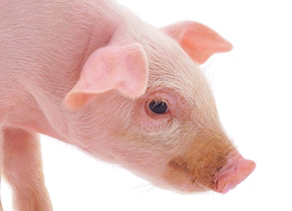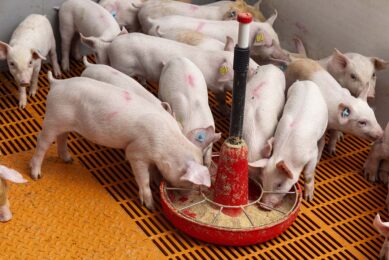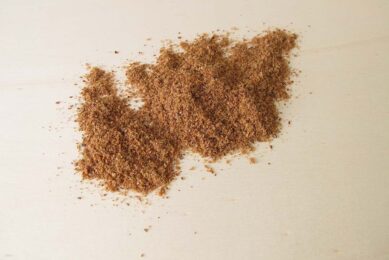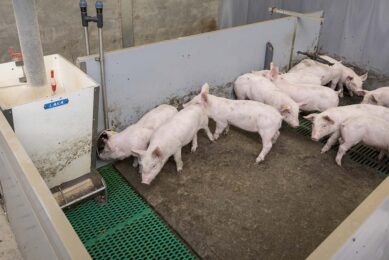Adisseo conference: pig gut health and economy

The US swine economy to intestinal health of piglets – all these issues were touched on at Adisseo’s fourth Swine Conference. The event was held in Paris, France, on February 2.
Over 50 nutritionists attended the annual meeting, whose common theme was the major role of feed in economic, technical and sanitary aspects of pig production.
US agricultural production
First of all, Pierre Sabatier, chairman of Primeview, explained how the US can reverse the trend of being overtaken by emerging countries like China and India, although these countries’ agricultural production is currently growing quicker. Like Europe, the US have a high potential of arable land.
He said, “The US have the capacity to almost double its cropland by the year 2050. This potential is bigger in South America, but is non-existent in Asia.” The US, he said, benefit from other structural assets, such as their military power and innovation capacity. But above all, he emphasised the fact that the country ‘has a unique ability to change its economic and agricultural trajectories thanks to remarkably pragmatic financial and political authorities, as illustrated over the past six years’.
Large scale units
Yves Tregaro, agro-economist, head of the animal products unit, FranceAgrimer, confirmed this point of view especially for the US pig production, with identified strengths such as large scale units. In total 60% of the pigs are bred on farms of more than 50,000 head; a high level of specialisation with increasing technical performance; contracts along the pig sector, the availability of corn and soybean… and 50% of the pig production is controlled by large integrators.
With a self-sufficiency rate of about 120% – 2 million tonnes – and production costs about 20% lower than in Europe in recent years, the US remain the first pig meat exporting country in the world, reaching 31% of world exports vs 30% for the EU. The economist showed that the Russian embargo has not really affected the pig industry, knowing that, before this embargo, Russia represented less than 6% of US pig meat exports.
However, the US show weaknesses, the main ones being environmental issues and sanitary control.
Anses
Gilles Salvat, head of the animal health and welfare unit, at the French Agency for Food, Environmental and Occupational Health & Safety (Anses), in Ploufragan, France, gave an insight into the impact of Porcine Epidemic Diarrhoea virus (PEDv) in the United States, where about 50 new disease outbreaks appear each month.
Knowing that the virus circulating in the USA is 99.5% identical to the virulent Chinese strain, one of the hypotheses is that this strain could have been introduced to America through a feed ingredient. He also summed up the opinion of the Anses Animal Health Expert Committee concerning the blood products incorporated in pig feed and suspected of spreading the virus in North America. Regarding the relationship between feed and health, he also described how animal feed can be involved in infectious diseases or foodborne zoonosis: vCJD in bovine, Salmonella, mycotoxins. But he concluded that ‘feed safety has never been as high and feed is an essential means to reinforce animal health’.
Feed and animal health
This relationship between feed and animal health was accompanied by a presentation by Dr Annemarie Rebel, head of the Infection Biology Department, Central Veterinary Institute of Wageningen, the Netherlands. She reported two experimentations demonstrating the influence of the intestinal system on pig health. The first trial, where piglets received antibiotics or not and were challenged with various stresses or not, showed that changes in early microbial colonisation are associated with changes in the intestinal immune system of growing pigs, with effects on the microbiota detectable until 176 days of age.
The second trial demonstrated that an amoxicillin treatment of sows via feed induces significant differences in the bacterial colonisation of the gut of their piglets. It also showed that sow vaginal microbiota shows an overlap with jejunual microbiota of the piglets at one day of age, suggesting the impact of vaginal microbiota of the sow on their piglets’ microflora composition and gene expression. She concluded: “It is thus possible to modulate the intestinal development as well as the microbiota of piglets through maternal feed intervention.”
Antioxidant solutions
In the same field, Peter Surai, Feed-Food, Scotland, reviewed antioxidant solutions for sows and piglets. Along with vitamin E, vitamin C, polyphenols and carotenoids, selenium is a major feed-derived antioxidant. Surai showed why storage of organic Se is essential and how Se in the sow’s diet impacts the concentration in the sow’s tissues, colostrum and milk but also the Se content in neonate pigs (serum, tissues, loin).
He reminded the audience that organic Se is more efficiently transferred via the placenta, the colostrum and the milk. He also compared the various forms of Se in pig nutrition: “Sodium selenite and selenate are products of yesterday, Se-yeasts have a SeMet content which is only 60-70% of the total Se whereas Seleno-Hydroxy-Methionine (Selisseo) seems to be the most effective product to date.”
Meta-analysis
In the final presentation, Pierre Cozannet, enzymes research manager Adisseo, summarised a meta-analysis performed on six trials around the world where an Non-Starch Polysaccharides (NSP) enzyme, Rovabio Excel, was tested on lactating sows. This meta-analysis allowed Rovabio to be the first NSP enzyme approved by European Union for sows last September.
It demonstrates a significant impact of this NSP enzyme on weight loss of sows during the lactating period, – with strongest effects being observed on the first parities – as well as a better litter weight gain. He concluded, “The use of Rovabio Excel improves the nutritional value of the feed and feed intake of the sow, leading to a minimum return on investment (ROI) of 20/1.”
A fifth Swine Conference willl be held in 2016.
Join 18,000+ subscribers
Subscribe to our newsletter to stay updated about all the need-to-know content in the pigsector, three times a week. Beheer
Beheer










 WP Admin
WP Admin  Bewerk bericht
Bewerk bericht